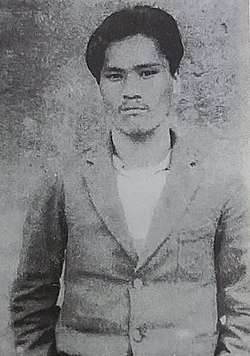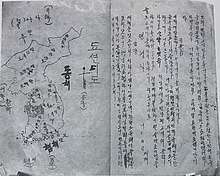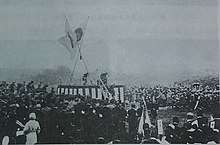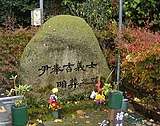Yun Bong-gil
Yun Bong-gil (21 June 1908 – 19 December 1932) was a Korean independence activist who set off a bomb that killed several Japanese dignitaries in Shanghai's Hongkew Park (now Lu Xun Park) in 1932. He was posthumously awarded the Republic of Korea Medal of Order of Merit for National Foundation in 1962 by the South Korean government.
| Yun Bong-gil | |
 Yun Bong-gil | |
| Korean name | |
|---|---|
| Hangul | |
| Hanja | |
| Revised Romanization | Yun Bong-gil |
| McCune–Reischauer | Yun Ponggil |
Yun Bong-gil memorials were built in South Korea (Seoul), China (Shanghai) and Japan (Kanazawa).
Early life
Yun Bong-gil was born in Yesan County in the twilight years of the Korean Empire in June 1908. He attended Deoksan Elementary School and also studied in Ochi Seosuk (a village school that taught Korean and Chinese). As Korea had been made a protectorate within the Japanese empire in 1905, Yun grew up in a troubled country. Local resistance grew considerably with the annexation of Korea in 1910. It culminated in the March 1st Movement in 1919 that was aggressively crushed by the Japanese authorities (hundreds of protesters were massacred by the Japanese police force and army).[1] The brutal repression that followed made many activists flee into China.
A rural social movement

To enlighten farmers, he wrote a textbook called Farmers Readers that called to organize evening schools to teach poor young adults in rural areas who could not attend school. For the development of farming villages, he founded a group called " Re-invigoration " to promote the revival of farming villages. On February 18 of that year, the center held a festival and performed a sketch titled " The Rabbit and the Fox. " Since there were not many cultural activities in the countryside, the audience gathered and finished it very successfully. This caused the Japanese police to pay attention. However, he continued his activities in rural areas and was appointed as the chairman of the Farmers ' Association, which was based on the movement. In addition, with the belief that rural development and the spirit of national independence can be raised in a healthy body, the government organized the Suam Sports Council to promote the health of farmers. [2]
By 1926 Yun had become an independence activist, starting evening classes in his home town to help educate people from rural communities about the issues. At the age of 20, he had organized a reading club and published several pamphlets.[3]
Exile to China

In 1930, after establishing two rural athletic associations for the nationalist movement, Yun decided to go to China because of the Japanese crackdown. He said, " I will not return home alive with the belief that I must die for my country and do something big.". He left for Manchuria after leaving a letter (1930. After his release from prison, he fled to Manchuria, met Kim Tae-sik and Han Il-jin, who are on the same path in Manchuria, and decided to seek independence.
Yoon Bong-gil headed for Shanghai, judging that he would be able to push for a successful independence movement only if he went to Korea's interim government. He went alone through Dalian, south of the Liaodong Peninsula, to Qingdao, Shandong Province. Working there, he saved money and looked for a place to plan independence. Finally, in August 1931, he arrived in Shanghai, where the provisional government was. He stayed at the home of Angonggeun in the French sector.
He attempted to find a job in China. First of all, he worked at a factory run by Park Jin, a Korean businessman. He also studied English at the Shanghai English School. He visited Kim Gu (1876-1976), the leader of the Provisional Government of the Republic of Korea in Shanghai, and promised to work for the independence of Korea.[4]
Hongkew Park Bombing

"I make this oath as a member of Korean Patriotic Association to kill the military leaders of the enemy who are invading Korea in order to redeem the independence and freedom of our country."
On 29 April 1932, Yun took a bomb disguised as a water bottle to a celebration arranged by the Imperial Japanese Army (IJA) in honor of Emperor Hirohito's birthday at Hongkew Park, Shanghai (one contemporary news report states Yun threw a hand grenade but they also say he was killed at the scene[5]). The bomb killed the government minister for Japanese residents in Shanghai, Kawabata Sadaji (河端貞次), and mortally wounded General Yoshinori Shirakawa, who died of his injuries on 26 May 1932.[6] Among the seriously injured were Lieutenant General Kenkichi Ueda, the commander of the 9th Division of the Imperial Japanese Army, and Mamoru Shigemitsu, Japanese Envoy in Shanghai, who both lost a leg. The Japanese Consul-General in Shanghai, Kuramatsu Murai (村井倉松), was seriously injured in the head and body.[7] Yun then tried to kill himself by detonating a second bomb disguised in a bento box. It did not explode and he was arrested at the scene. The Illustrated London News reported that:
- "The Japanese National Anthem was being played, when a youth was seen to step forward and place a cylinder on the front of the dais and then dart backwards. A dull explosion immediately followed, but it attracted so little attention that the music continued playing. [...] others were seen to collapse wounded and bleeding, while soldiers seized the youth and battered him. Subsequently, another bomb of the same pattern was found near the dais unexploded."[8]
After being convicted by a Japanese military court in Shanghai on 25 May, he was transferred to Osaka prison on 18 November. He was then moved to Kanazawa, Ishikawa: the headquarters of the IJA's 9th Division. Yun was executed by firing squad on 19 December.[3] His body was buried in Nodayama cemetery in Kanazawa.

The then-President of the Chinese Republic, Chiang Kai-shek of the Kuomintang government, praised Yun's actions, stating he was "a young Korean patriot who has accomplished something tens of thousands of Chinese soldiers could not do".[9][10][11] However the future South Korean president, Syngman Rhee, disapproved of the incident and Kim Koo's strategy of assassinations as a means to achieve independence because the Japanese could use such attacks to justify their oppression in Korea.[7]
Legacy
Funeral and honours


In May 1946, Korean residents in Japan exhumed Yun's remains from Nodayama cemetery. After being transferred to Seoul, they were given Korean funeral rites and reburied in the Korean National Cemetery.
On 1 March 1962, the South Korean government posthumously bestowed on him the Republic of Korea Cordon (the highest honor) of the Order of Merit for National Foundation.
In 27 March 1968, Chiang Kai-shek, the president of Republic of China in exile in Taiwan, wrote a prose to applaud Yun's action in the request of Yun's biographer, which was not revealed until 18 Dec 2013.[12]
Memorials
Yun Bong-gil Memorial Hall was built in commemoration of the 55th anniversary of his death.[13] It is located in Yangjae Citizen's Forest, Seocho-gu, Seoul Yangjaedong. Second name of Yangjae Citizen's Forest Station is 'Maeheon' which is named after his pen name.
There is also a memorial hall called the Plum Pavilion in Lu Xun Park, Shanghai where the bomb throwing incident happened.[14]
In Kanazawa, Ishikawa, Japan, a monument was built on the site where Yun Bong-gil was buried after being executed by the Imperial Japanese Army.
Controversies
Today it is a sensitive issue in South Korea to discuss whether Yun's bombing attack in 1932 would be have been considered as terrorism in the modern context. In 2007, Anders Karlsson, a visiting Swedish scholar from SOAS, University of London, compared Yun Bong-gil and Kim Gu to terrorists in his lecture on Korean history. His terming provoked strong criticism from the newspaper JoongAng Ilbo. Prof. Jeong Byeong-jun, interviewed by JoongAng Ilbo, dismissed Karlsson's description as the "view of Westerners".[15] Later he explained his purpose was to highlight "how the implications of the 'terrorism' have changed over the course of the past century".[16] In 2013, Tessa Morris-Suzuki, an English historian and professor at Australian National University, concurred with Karlsson's explanation and wrote in her academic article, "If we accept the literal dictionary definition of the term terrorists as partisan, member of a resistance organization or guerrilla force using acts of violence then Yoo was self-evidently a terrorist."[16]
On the other hand, at the "International Research Conference in Memory of the 70th Anniversary of Yun Bong-gil & Lee Bong-chang's Patriotic Acts" held on 29 April 2002 in Shanghai, some scholars present pointed out that Yun's patriotic acts have distinct differences from modern day terrorism, which targets civilians. Yun only attacked the Japanese top military and political officials attending the event, and no other civilians were hurt by the bombing. To protect civilians, Yun waited until all the diplomats had left the scene.[17]
See also
References
- "March First Movement". Britannica Online Encyclopedia. Retrieved 2 June 2015.
- "윤봉길" (in Korean). Retrieved 16 June 2018.
- "In memory of Yun Bong-gil and His Bombing in Shanghai". Ministry of Patriots & Veterans Affairs. 29 April 2008.
- "윤봉길" (in Korean). Retrieved 16 June 2018.
- "BOMB THROWN in Shanghai". The Sydney Morning Herald. 30 April 1932. Retrieved 2 June 2015.
- "Yun Bong-gil". World War II Database. Retrieved 2 June 2015.
- Lee, Bong (2003). The Unfinished War: Korea. Algora Publishing. p. 13.
- "The Bombing of Japanese Leaders at Shanghai". The Illustrated London News. 28 May 1932.
- "上韩国临时政府在华二十六年". 北京文摘. 14 December 2017. Archived from the original on 2 August 2018. Retrieved 2 August 2018.
- ""尹奉吉之伟业永垂不朽" 蒋介石献诗被公开". 中央日报. 19 December 2013. Archived from the original on 6 August 2018. Retrieved 6 August 2018.
- "The emotional ties that bind forever". www.chinadailyasia.com. 27 May 2014.
- 백성호 (19 December 2013). ""윤봉길 길이 빛나리" 장제스 헌시 공개". Joongang Ilbo.
- "About Yun Bong-gil".
- "Naver Knowledge encyclopedia" (in Korean).
- "Foreign Professor Calls Kim Gu, Yun Bong-gil 'Terrorists': Report". www.rjkoehler.com. Archived from the original on 30 May 2015. Retrieved 20 May 2015.
- Tessa Morris-Suzuki (2013). "Heroes collaborators and survivors: Korean kamikaze pilots and the ghosts of wars in Japan and Korea". ANU Research Publications. hdl:1885/49976.
- 崔志鹰 (2002). "上海召开"纪念尹奉吉、李奉昌义举70周年国际学术会议"". Contemporary Korea (《当代韩国》) (in Chinese). 02.
尹奉吉的义举不能与当代被世人所谴责的恐怖活动相提并论。现代的恐怖活动是伤害无辜的平民百姓, 制造恐怖的气氛。而尹奉吉的刺杀行动是针对日本侵略者的头目, 是反抗侵略和压迫的正义行动, 他没有伤及任何一个无辜的平民百姓。当时, 尹奉吉为了不伤害无辜, 他冒着被发现的危险, 等到各国外交人员全部离开之后,才扔出炸弹。......义烈斗争并非简单的个人的恐怖行动, 它是韩国独立运动的一种方略, 在当时的历史条件下,是唯一能选择的斗争方式。